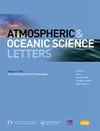Impact of ocean data assimilation on the seasonal forecast of the 2014/15 marine heatwave in the Northeast Pacific Ocean
IF 3.2
4区 地球科学
Q3 METEOROLOGY & ATMOSPHERIC SCIENCES
引用次数: 0
Abstract
A remarkable marine heatwave, known as the “Blob”, occurred in the Northeast Pacific Ocean from late 2013 to early 2016, which displayed strong warm anomalies extending from the surface to a depth of 300 m. This study employed two assimilation schemes based on the global Climate Forecast System of Nanjing University of Information Science (NUIST-CFS 1.0) to investigate the impact of ocean data assimilation on the seasonal prediction of this extreme marine heatwave. The sea surface temperature (SST) nudging scheme assimilates SST only, while the deterministic ensemble Kalman filter (EnKF) scheme assimilates observations from the surface to the deep ocean. The latter notably improves the forecasting skill for subsurface temperature anomalies, especially at the depth of 100–300 m (the lower layer), outperforming the SST nudging scheme. It excels in predicting both horizontal and vertical heat transport in the lower layer, contributing to improved forecasts of the lower-layer warming during the Blob. These improvements stem from the assimilation of subsurface observational data, which are important in predicting the upper-ocean conditions. The results suggest that assimilating ocean data with the EnKF scheme significantly enhances the accuracy in predicting subsurface temperature anomalies during the Blob and offers better understanding of its underlying mechanisms.
摘要
2013年底至2016年初, 东北太平洋上发生了历史上罕见的极端海洋热浪事件 (称为“Blob”事件) , 形成了从海表延伸至海洋深处300m的强烈且持续的海温暖异常. 本文利用南京信息工程大学全球气候预测系统1.0版本 (NUIST-CFS 1.0) , 采用两种海洋资料同化方案, 探究海洋资料同化差异对这一极端海洋热浪事件季节预测的影响. 本文采用的一种同化方案为仅同化海表面温度 (Surface sea temperature, SST) 的SST-nudging方案, 而另一种方案为在前一种方案的基础上加入确定性集合卡尔曼滤波 (Deterministic Ensemble Kalman Filter, DEnKF) , 同化更多海洋观测数据的EnKF方案. 主要结论为, 利用EnKF方案可显著提高对“Blob”期间次表层温度异常预测的准确性, 这主要源于EnKF方案在预测次表层的水平和垂直热传输方面表现出色. 该研究有助于更好地理解海洋热浪事件潜在物理机制及其季节预测水平.

海洋数据同化对东北太平洋 2014/15 年海洋热浪季节性预报的影响
2013年底至2016年初,东北太平洋出现了一次引人注目的海洋热浪,被称为“Blob”,从表面延伸到300米深处,显示出强烈的温暖异常。本研究采用基于南京信息工程大学全球气候预报系统(NUIST-CFS 1.0)的两种同化方案,探讨了海洋资料同化对此次海洋极端热浪季节预报的影响。海表温度(SST)推动方案只同化海表温度,而确定性集合卡尔曼滤波(EnKF)方案同化从表层到深海的观测。后者显著提高了对地下温度异常的预测能力,特别是在100-300 m深度(下层),优于海温推动方案。它在预测低层的水平和垂直热输送方面都表现出色,有助于改进对团团期间低层变暖的预测。这些改进源于地下观测资料的同化,这对预测上层海洋条件很重要。结果表明,利用EnKF方案吸收海洋数据显著提高了预测Blob期间地下温度异常的精度,并有助于更好地理解其潜在机制。摘要2013年底至2016年初,东北太平洋上发生了历史上罕见的极端海洋热浪事件(称为“Blob”事件),形成了从海表延伸至海洋深处300米的强烈且持续的海温暖异常。本文利用南京信息工程大学全球气候预测系统1.0版本(NUIST-CFS 1.0),采用两种海洋资料同化方案,探究海洋资料同化差异对这一极端海洋热浪事件季节预测的影响。本文采用的一种同化方案为仅同化海表面温度(海表面温度、风场的SST-nudging方案,而另一种方案为在前一种方案的基础上加入确定性集合卡尔曼滤波(确定性合奏卡尔曼滤波器,DEnKF),同化更多海洋观测数据的EnKF方案。主要结论为,利用EnKF方案可显著提高对“Blob”期间次表层温度异常预测的准确性,这主要源于EnKF方案在预测次表层的水平和垂直热传输方面表现出色。该研究有助于更好地理解海洋热浪事件潜在物理机制及其季节预测水平.
本文章由计算机程序翻译,如有差异,请以英文原文为准。
求助全文
约1分钟内获得全文
求助全文
来源期刊

Atmospheric and Oceanic Science Letters
METEOROLOGY & ATMOSPHERIC SCIENCES-
CiteScore
4.20
自引率
8.70%
发文量
925
审稿时长
12 weeks
 求助内容:
求助内容: 应助结果提醒方式:
应助结果提醒方式:


